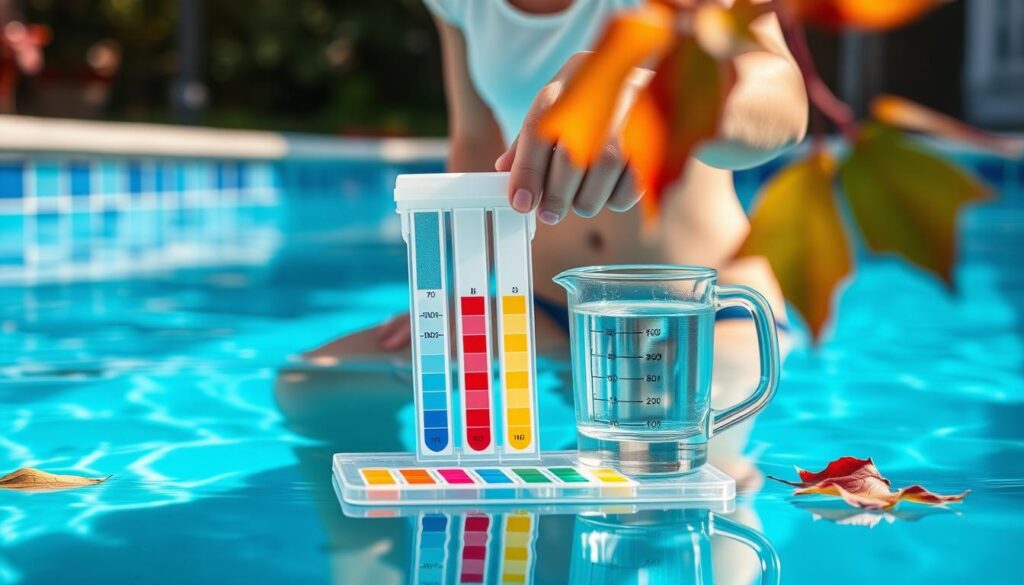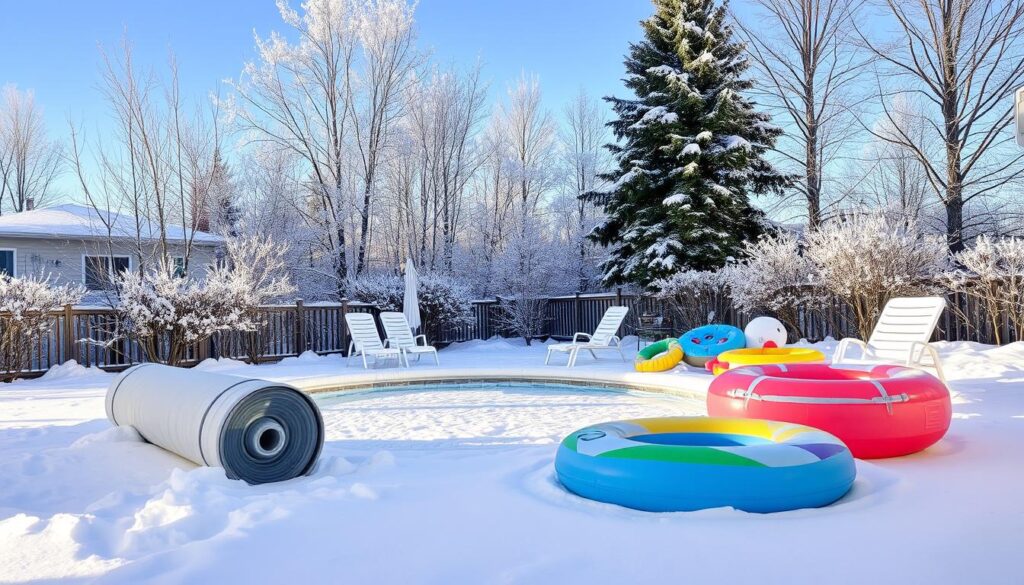As leaves fall and temperatures drop, it’s time to winterize your pool. This process protects it from cold weather damage. It also makes spring opening easier. Winter pool prep is more than just covering your pool. It’s a detailed approach to care that keeps your investment safe.
Winterizing your pool involves several steps. You need to clean and balance the water chemistry. You also have to protect your equipment and install a winter cover. By following a detailed winter prep plan, you’ll avoid expensive repairs. Your pool will stay in great shape all off-season.
Essential Pool Winterization Tools and Materials You’ll Need
Getting your pool ready for winter means having the right supplies. A good pool closing kit has everything you need to keep your pool safe during the cold months. Let’s look at the key items for a successful winterization.
Chemical Testing and Balancing Supplies
First, use a water testing kit to check your pool’s chemicals. You’ll need pH adjusters, alkalinity increasers, and chlorine to balance the water. Also, algaecide and pool shock are important for a final treatment.
Winterization Kit Components
A complete pool closing kit usually has:
- Winterization plugs for return lines
- Skimmer plates to seal off skimmers
- Pool antifreeze for pipes
- Thread seal tape for secure connections
- Gizzmo or ice compensator for skimmers
Pool Covers and Hardware
A good winter pool cover is key to protecting your pool. Choose between mesh or solid covers based on your area’s weather. Don’t forget cover clips, water bags, or anchors to keep your cover in place.
| Cover Type | Benefits | Drawbacks |
|---|---|---|
| Mesh Cover | Allows water through, prevents debris buildup | Requires more spring cleaning |
| Solid Cover | Blocks all debris and sunlight | Needs pump to remove standing water |
With these supplies, you’re ready to protect your pool all winter. Quality materials now save you time and money when you open your pool in spring.
Best Time to Start Your Pool Winterization Process
Timing is key when it comes to winterizing your pool. The best time to start depends on your local weather and water temperature. In the U.S., most people start closing their pools in late September or early October.
Watch your pool’s water temperature closely. When it stays below 65°F (18°C), it’s time to winterize. This temperature helps slow down algae and bacteria, making water care easier during winter.
Also, check the weather forecast. Try to finish winterizing before the first frost. This protects your pool equipment from freezing damage.
| Climate Zone | Ideal Winterization Timing | Water Temperature |
|---|---|---|
| Northern States | Late September – Early October | Below 60°F |
| Mid-Atlantic | Mid-October – Early November | Below 65°F |
| Southern States | Late November – Early December | Below 70°F |
Having a good pool winterization plan is crucial. By following these guidelines, you’ll keep your pool in great shape all winter. And it will be ready for a smooth start in the spring.
How to Properly Clean Your Pool Before Winter
Pre-winter pool cleaning is key to keeping your pool in great shape during the cold months. Let’s explore the important steps for a deep clean.
Deep Cleaning the Pool Walls and Floor
Begin by brushing your pool’s walls and floor. This step removes algae and debris that could harm surfaces over winter. Next, vacuum the pool to get rid of loose dirt and sediment. Choose a vacuum that fits your pool type for the best results.
Clearing the Skimmer and Pump Baskets
Empty and clean your skimmer and pump baskets. This action prevents clogs and keeps water flowing well. Rinse the baskets well and inspect for any damage or cracks.
Removing Pool Accessories and Equipment
Removing pool accessories is crucial for winterizing. Take out ladders, slides, diving boards, and toys. Clean these items before storing them in a dry spot. This step prevents rust and extends the life of your pool equipment.
| Pool Area | Cleaning Method | Tools Needed |
|---|---|---|
| Walls and Floor | Brushing and Vacuuming | Pool Brush, Vacuum |
| Skimmer/Pump Baskets | Emptying and Rinsing | Hose, Bucket |
| Accessories | Removal and Storage | Cleaning Cloth, Storage Containers |
By following these steps, you’ll make sure your pool is clean and ready for winter. This thorough cleaning will make opening your pool in spring much simpler.
Balancing Your Pool Water Chemistry
Keeping your pool water chemistry right is key for winter. It’s important to balance pH levels and add winter chemicals. This protects your pool from damage during the cold months. Let’s explore how to keep your pool water chemistry perfect for winter.
Ideal pH and Alkalinity Levels
It’s crucial to keep your pool’s pH balanced. Aim for a pH between 7.2 and 7.6. This stops corrosion and scale buildup. Use a good test kit to check these levels.

Chlorine and Sanitizer Requirements
Chlorine levels should be 1 to 3 ppm for good sanitization. If you use other sanitizers, follow the maker’s winter guidelines. Good sanitization stops algae in the off-season.
Adding Winter Chemical Treatment
Winter chemicals are key to protecting your pool. Add a winter algaecide to stop algae. Use a metal sequestrant to stop stains from metals. Lastly, add a winter enzyme treatment to break down organic stuff.
| Chemical | Purpose | Recommended Level |
|---|---|---|
| pH | Prevents corrosion and scale | 7.2 – 7.6 |
| Alkalinity | Stabilizes pH | 80 – 120 ppm |
| Chlorine | Sanitizes water | 1 – 3 ppm |
| Algaecide | Prevents algae growth | As per product instructions |
By balancing your pool’s water chemistry and using the right winter chemicals, your pool will be safe all winter. This prep makes spring opening easy and keeps your pool healthy for next year.
Lowering the Pool Water Level Correctly
Draining your pool for winter is a key step. It helps avoid damage from freezing and thawing. Let’s look at how to set the right water level for winter.
The right water level depends on your pool type and where you live. For inground pools, lower the water 4-6 inches below the skimmer. Above-ground pools need a level 4 inches below the return jets.
To adjust your pool’s water level:
- Use a submersible pump or your pool’s main drain to remove water
- Keep an eye on the water level as it goes down
- Stop draining when you hit the recommended level for your pool
Don’t drain too much water. It can cause the pool cover to sag or damage the structure. If you live in an area with high water tables, get a pro to find the best water level for winter.
| Pool Type | Recommended Water Level | Considerations |
|---|---|---|
| Inground | 4-6 inches below skimmer | Protect skimmer from freezing |
| Above-ground | 4 inches below return jets | Prevent ice damage to wall panels |
| Vinyl-lined | 1-2 inches below skimmer | Avoid liner shrinkage |
Getting the pool water level right is crucial for winterizing. Take your time and check your measurements carefully. This way, your pool will stay safe during the cold months.
How to Winterize Your Pool Plumbing and Equipment
Winterizing your pool plumbing is key to avoid damage from freezing. It involves several important steps. These steps help keep your pool safe during the cold months.
Draining Pool Equipment
First, turn off your pool system’s power. Drain water from pumps, filters, and heaters. Remove drain plugs and keep them safe.
Open all valves to let water flow out fully.
Blowing Out the Lines
Blowing out the lines is crucial. Use an air compressor or shop vac to push air through the plumbing. This removes any remaining water, preventing damage from freezing.
Start from the pump and move to each return line. This ensures all lines are clear.
Adding Antifreeze When Necessary
In very cold areas, you might need pool antifreeze. After blowing out lines, add antifreeze to the skimmer and return lines. This extra step helps protect against freezing.
Remember, proper winterization is vital to avoid expensive repairs in spring. Take your time and check each step carefully. This way, your pool will stay safe all winter.
Installing Your Winter Pool Cover
Installing a winter pool cover is key to protecting your pool in the cold months. A good cover keeps out debris and weather, making spring easier. It’s a big step in pool care.
Safety Cover Installation Steps
Begin by placing your safety cover over the pool. Make sure it’s centered and tight. Then, mark where to put the safety cover anchors.
Drill holes at these spots and insert the anchors. Use springs or straps to attach the cover to the anchors.
Securing Cover Anchors and Springs
Make sure all safety cover anchors are secure. Adjust the springs or straps to keep the cover tight. This stops sagging and water pooling, which can harm the cover.
Water Bag Placement Guidelines
For above-ground pools or solid covers, water bags are crucial. Place them around the cover’s edge, overlapping for full coverage. Fill them about 3/4 full to handle freezing water.
| Cover Type | Securing Method | Maintenance |
|---|---|---|
| Safety Cover | Anchors and Springs | Check tension monthly |
| Solid Cover | Water Bags | Refill bags as needed |
| Mesh Cover | Anchors and Cables | Remove debris regularly |
Proper water bag placement is vital for a secure cover all winter. Follow these steps to keep your pool safe until spring.
Protecting Pool Equipment During Winter
Keeping your pool equipment safe during winter is key. First, take out items like ladders and skimmer baskets. Clean them well and store them in a dry place, away from bad weather.
To protect pumps and filters, drain all water from them. Remove the drain plugs and keep them in the pump basket. Use a waterproof cover to keep snow and ice off.

Winterizing your pool heater is also important. Drain all water and use a shop vac to remove any moisture. If you have a gas line, disconnect it. Then, cover the heater with a weatherproof cover.
| Equipment | Winterization Steps |
|---|---|
| Pump | Drain water, remove plugs, cover with tarp |
| Filter | Backwash, drain, remove cartridges if applicable |
| Heater | Drain water, disconnect gas, cover |
| Chlorinator | Remove remaining chemicals, rinse, store indoors |
By following these steps, you’ll keep your equipment ready for the next swimming season. This includes winterizing your pool equipment, protecting pumps and filters, and taking care of your pool heater.
Common Pool Winterization Mistakes to Avoid
Winterizing your pool is key to its long life. Yet, many homeowners make mistakes that can cost a lot. Knowing common errors helps keep your pool safe during winter.
Timing Errors to Watch For
One big mistake is closing your pool too early or too late. Closing too soon can cause algae. Waiting too long can damage your equipment from freezing. Close your pool when nighttime temperatures are usually below 65°F.
Chemical Balance Mistakes
Ignoring the right chemical balance is another error. Wrong pH levels can cause scaling or corrosion. Before closing, check your water’s pH, alkalinity, and chlorine levels. They should be between 7.2 and 7.6, 80-120 ppm, and 1-3 ppm, respectively.
Equipment Protection Oversights
Not draining and protecting your equipment is a common mistake. Remove all water from pumps, filters, and heaters to avoid freeze damage. Use pool-grade antifreeze in plumbing lines for harsh winters.
- Drain all equipment thoroughly
- Remove and store removable parts
- Cover exposed equipment to protect from snow and ice
Avoiding these mistakes ensures a smooth pool opening in spring. Winterizing correctly saves you trouble when swim season arrives.
Monitoring Your Pool Throughout Winter
Winter pool maintenance doesn’t stop when you close your pool. Regular checks are key for off-season care. Your winterized pool needs attention to avoid problems and make spring opening smoother.
Regular Cover Checks
Check your pool cover every week. Look for tears, sagging, or debris. A damaged cover can let in dirt and melt water, harming your pool’s cleanliness.
Remove leaves and twigs to prevent staining and extend your cover’s life.
Managing Snow and Ice Load
In snowy areas, removing snow from pool covers is crucial. Use a roof rake or soft broom to gently clear heavy snow. Avoid letting ice form on the cover – it can damage the material.
If ice forms, wait for it to melt naturally instead of trying to break it.
Water Level Maintenance
Watch your pool’s water level all winter. It should be about 4-6 inches below the skimmer. If it drops too low, add water to protect the pool structure.
If it rises too high, remove excess water to protect your cover and prevent overflow.
FAQ
When is the best time to winterize my pool?
Winterize your pool when the water temperature stays below 65°F (18°C). This usually happens in late fall. The exact time varies by your local climate. Start before the first frost to protect your pool from freeze damage.
What essential tools do I need for pool winterization?
You’ll need a water testing kit, pool chemicals, a brush, vacuum, and winterization plugs. Also, a pool cover, preferably a safety cover, and possibly pool antifreeze. For lots of plumbing, an air compressor or shop vac might be needed.
How do I balance my pool water for winter?
Aim for a pH of 7.2 to 7.6, alkalinity of 80-120 ppm, and calcium hardness of 175-225 ppm for vinyl pools. For concrete pools, aim for 200-250 ppm. Use a winter chemical kit with algaecide and enzymes to prevent algae.
Should I completely drain my pool for winter?
No, don’t drain your pool completely. Lower the water level to 4-6 inches below the skimmer opening for mesh covers. For solid covers, lower it to 4-6 inches below the tile line. This prevents damage from freezing while keeping the cover stable.
How do I protect my pool plumbing from freezing?
Drain water from the pump, filter, heater, and chlorinator. Use an air compressor or shop vac to blow out the lines. Then, plug them with winterization plugs. In severe winters, add pool antifreeze for extra protection.
What type of pool cover is best for winter?
A safety cover is the best for winter. They are strong, durable, and safe. They also keep debris out better than standard winter covers or tarps.
How often should I check my pool during winter?
Check your pool at least once a week in winter. Look for damage to the cover and remove excess water or debris. After heavy snow, remove snow load from the cover carefully.
Can I use my regular pool chlorine for winterization?
You can use regular chlorine to shock the pool before closing. But, use a winter chemical kit for the final treatment. These kits provide long-lasting protection and include slow-release chlorine and algaecide.
What’s the biggest mistake people make when winterizing their pool?
Not balancing the water chemistry before closing is a big mistake. Imbalanced water can cause staining, scaling, and algae growth. Always balance your water and shock the pool before adding winter chemicals.
Do I need to winterize my above-ground pool?
Yes, winterize your above-ground pool like in-ground pools. Clean, balance chemicals, lower the water level, protect plumbing, and cover the pool. Above-ground pools are more prone to freeze damage, so proper winterization is key.


